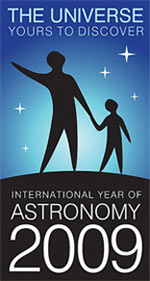UT’s Ritter Planetarium and the Toledo-Lucas County Public Library will collaborate to take visitors on a journey to the center of the galaxy with the unveiling of unprecedented mural-sized images of the Milky Way’s core as seen by NASA’s Hubble Space Telescope, Spitzer Space Telescope and Chandra X-ray Observatory.
 The images will be unveiled Friday, Nov. 13, at 7 p.m. at the University and Tuesday, Nov. 24, at 6 p.m. at the main branch of the library.
The images will be unveiled Friday, Nov. 13, at 7 p.m. at the University and Tuesday, Nov. 24, at 6 p.m. at the main branch of the library.
Dr. Nancy Morrison, UT professor of astronomy and director of Ritter Planetarium, will unveil the photographs of the central region of the galaxy that commemorate the International Year of Astronomy.
The International Year of Astronomy 2009 celebrates the 400th anniversary of Galileo turning a telescope to the heavens. Since Galileo’s spyglass, telescopes have grown larger and better, and have moved to mountaintops and into space. NASA’s Great Observatories represent the crowning achievements of astronomy four centuries later and are honoring this legacy with a national image unveiling. Ritter Planetarium and the Toledo-Lucas County Public Library will display these unprecedented images to the people of Toledo.
A giant 6-foot-by-3-foot image presents a view that showcases the galaxy in near-infrared light observed by Hubble, infrared light observed by Spitzer, and X-ray light observed by Chandra. This combined image was carefully assembled from mosaic photo surveys of the core by each telescope. It provides the most wide-ranging view ever of the galaxy’s mysterious hub.
Ritter Planetarium and the Toledo-Lucas County Public Library also will unveil a matched trio of Hubble, Spitzer and Chandra images of the Milky Way’s center on a second large panel measuring 3 feet by 4 feet. Each image shows the telescope’s different wavelength view of the central region of the galaxy that illustrates not only the specific science each observatory conducts, but also how far astronomy has come since Galileo.
Within these images one can trace the spectacle of stellar evolution: from vibrant regions of star birth, to young hot stars, to old cool stars, to seething remnants of stellar death called black holes. This activity occurs against a fiery backdrop in the crowded, hostile environment of the galaxy’s core, the center of which is dominated by a super-massive black hole millions of times more massive than the sun.
These multi-wavelength views provide both beauty and a wealth of scientific information that could not have been dreamed of by Galileo.
Additional information about the Hubble Space Telescope is available at http://hubblesite.org/. Additional information about the Spitzer Space Telescope is available at http://www.spitzer.caltech.edu/. Additional information about the Chandra X-ray Observatory is available at http://chandra.harvard.edu/. Additional information about NASA’s celebration of the International Year of Astronomy is available at http://astronomy2009.nasa.gov/.
After the unveiling, the new images will be on permanent display in the lobby of Ritter Planetarium and at the library.
For more information, call 419.530.2650 or see www.utoledo.edu/as/rpbo.